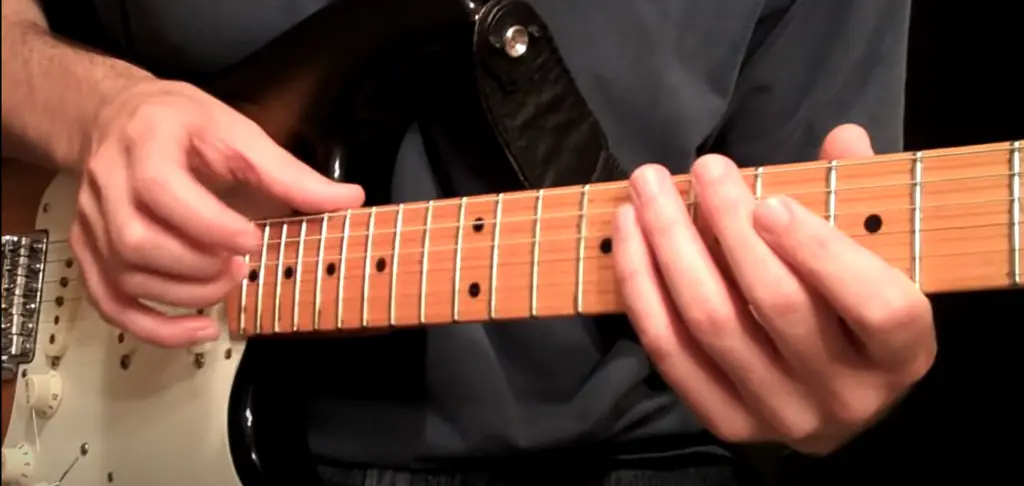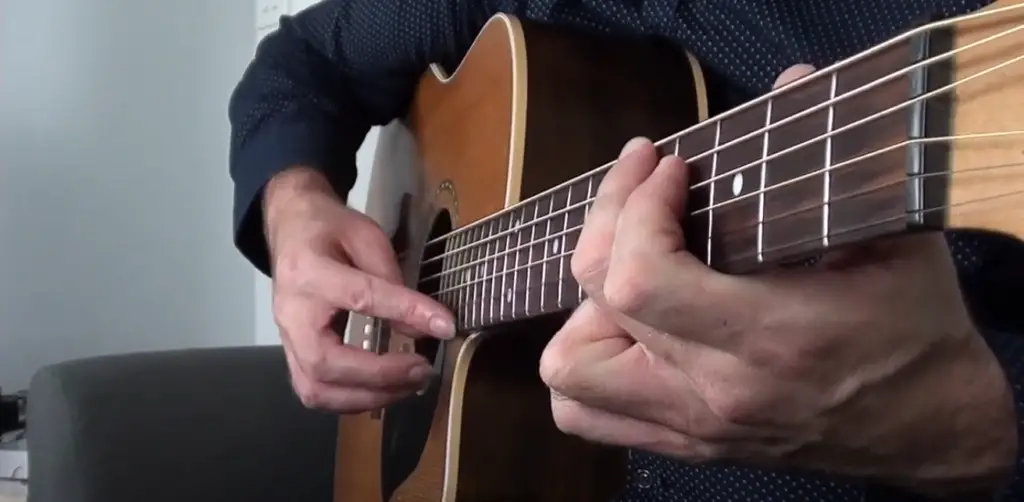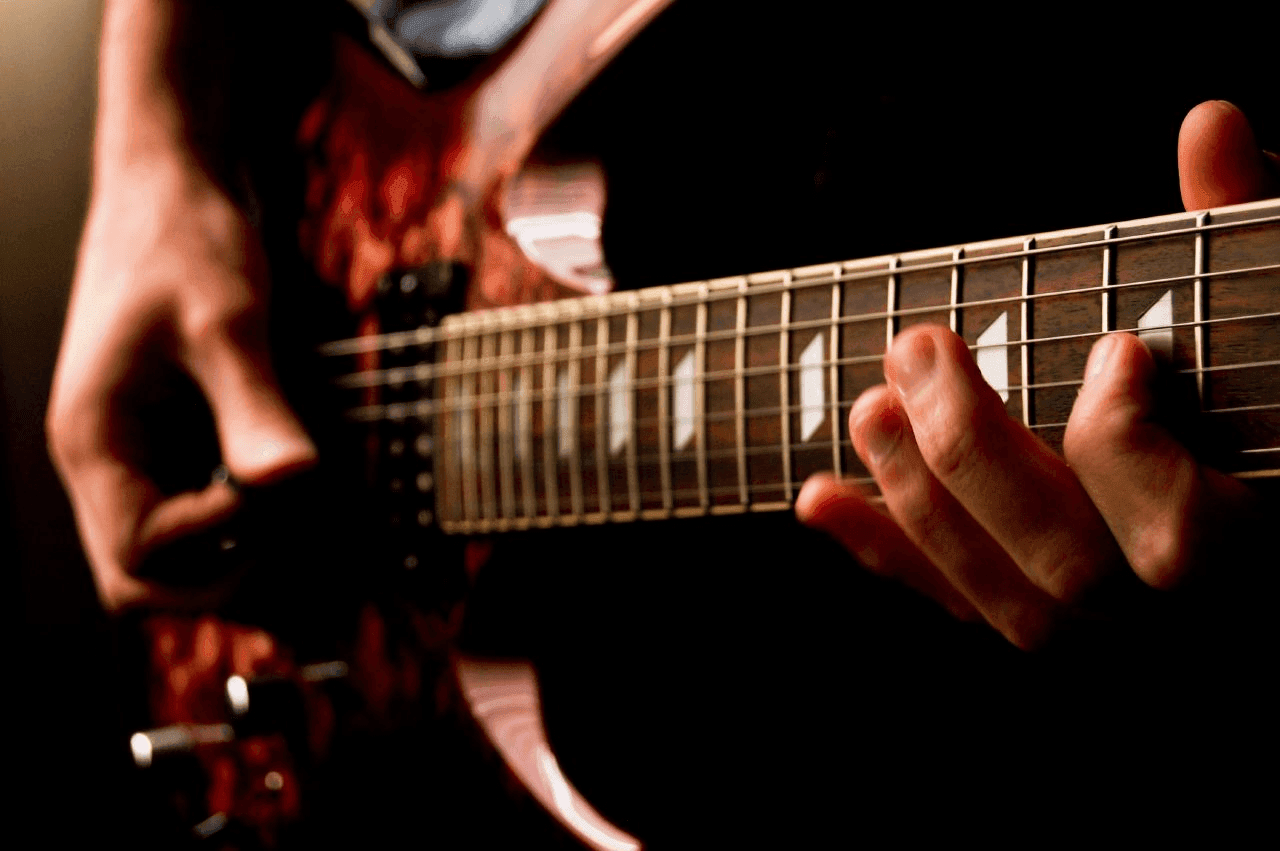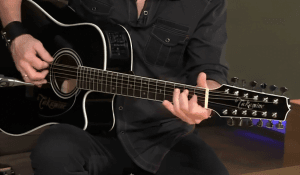Table of Contents
Any guitarist who has moved past their noob days is bound to have heard of artificial harmonics. Artificial and pinch harmonics are a must-learn technique if you’re an aspiring virtuoso or even a casual intermediate player.
You can make your guitar sing with these. Keep reading to learn the A to Z of artificial harmonics – what they are, how they are used, and how to learn them.
Before that, check out the best classical guitars on a budget.
How do you play Artificial Harmonics?
Artificial harmonics in guitar is a unique and expressive technique that allows a guitarist to produce harmonically rich and distinctive sounds. Pinch, tapped, and harp harmonics fall within the category of artificial harmonics.
Characteristics Of Artificial Harmonics
To play artificial harmonics, press down a string with your left hand to fret a note and the string 12 frets higher with your right-hand index finger, then pluck the string with your right-hand thumb or a pick.
Production Technique
Artificial harmonics are produced by combining standard picking or plucking with lightly touching the vibrating string with various parts of the picking hand. The point of contact with the thumb divides the string into segments, creating harmonic nodes.
Squealing Sound
Artificial harmonics are known for their distinctive, high-pitched, and often “squealing” sound, though some, like harp harmonics, provide soothing sounds.
Pitch Variation
The exact pitch of the artificial harmonic depends on the point along the string where the thumb touches. By adjusting the position of the thumb, guitarists can produce a wide range of harmonic pitches, unlike the limited natural harmonics.
Intense and Expressive
Artificial harmonics can introduce intensity and expression into guitar solos or musical compositions. Rock and metal genres often use them to create a high-energy and dramatic effect.
Advanced Technique
Mastering artificial harmonics requires precision and control. Due to the specific finger placement and hand coordination, guitarists can struggle to consistently produce clean harmonics, so artificial harmonics are often considered an advanced guitar technique.
Hit in Heavy Music
Artificial harmonics are used in various musical styles but are most prominent in rock and metal music. Guitarists like Zakk Wylde, Dimebag Darrell, and Eddie Van Halen are known for their skillful use of artificial harmonics to excite their solos.
Effect Pedals
Some guitarists use effect pedals to enhance the sound of artificial harmonics further. These pedals can add distortion, reverb, delay, or other effects that make the harmonics even more pronounced.
The Physics Behind Artificial Harmonics

Artificial harmonics are produced by manipulating the string to emphasize one of these harmonic nodes, just as natural harmonics do.
However, instead of lightly touching the string at the nodal point, you use your picking hand’s index finger to touch the string. This essentially changes the length of the vibrating portion of the string.
This creates a situation where you have effectively divided the string into two shorter and one longer parts, accentuating the harmonic frequency related to the new length.
You momentarily activate the harmonic overtone corresponding to that node when you strike the string with the pick while touching it at the nodal point. The pick’s edge, applied at the correct position, makes this harmonic sound prominent.
After picking, the string is muted by the edge of the thumb, preventing the fundamental frequency from interfering.
Find Guitars on Amazon.
Techniques for Playing Artificial Harmonics

Pinch Harmonics
Performing pinch harmonics on the guitar, or artificial harmonics, can add a unique and expressive element to your playing. Here’s how to do pinch harmonics:
Set the Tone
Pinch harmonics work best with overdriven and distorted tones. Delay and reverb help fatten the sound a lot. Keeping the pickup at the bridge position gives the harmonics an edge to cut through the soundscape.
Hold the Pick
Start by holding your guitar pick with your index finger parallel to it and thumb perpendicular. You should have a firm but not too tight grip on the pick. A small portion of the pick’s edge should be exposed.
Select the Position
Identify the spot on the string where you want to create the pinch harmonic. Common harmonic positions are over the guitar’s pickups, where the string has maximum harmonics. You can also experiment with other locations for different harmonic tones.
Pick and Touch Simultaneously
As you pick the string, use the flesh of your thumb (the part closer to the side of your nail) on your picking hand to lightly graze or brush against it immediately after picking it. This touch should be made at the precise spot you selected in step 2.
Identify the Right Touch
The key to successful pinch harmonics is your picking hand’s touch and angle. Experiment with different angles of attack to find the “sweet spot” on the string that produces the clearest and most pronounced harmonic. This might require some trial and error to get right.
Muting and Release
Release the string as soon as you’ve touched the string and produced the harmonic. Simultaneously, mute the string you just played with your fretting hand. This prevents the fundamental note from sustaining and allows the harmonic to ring out clearly. You can use the side of your palm to mute the strings after you’ve picked them.
Practice and Refinement
Start slowly and gradually increase your speed as you become more comfortable. Try different harmonic positions and experiment with the intensity of your touch for varying harmonics.
Add Expression
You can add vibratos of varying widths to embellish your pinch harmonics.
Tapped Harmonics
Tapped harmonics are also known as touch harmonics. It is a guitar technique that allows you to create harmonically rich sounds by tapping the strings in a specific way. Here’s how to perform tapped harmonics:

Prepare Your Tone
Make sure that your amplifier or effects settings have a clean tone. Tapped harmonics work best with a clean sound, which allows the harmonics to ring out clearly.
Select the Note and Harmonic
Decide on the note you want to play and the corresponding harmonic you wish to emphasize. Remember that the harmonic will be an octave (12 frets) above the note you tap.
Fret the Note
Use your fretting hand to press down on the string at the desired fret and position to play the note. For example, fret that note if you want to play the 5th fret of the high E string.
Position Your Tapping Hand
Bring your tapping hand above the guitar’s neck. Your thumb should parallel the fretboard, and your fingers should curve slightly. If you’re using a pick to tap the fret, ensure it is diagonal to the string.
Tapping the Harmonic
Place the pick or your preferred tapping hand finger, whichever you’re using, directly above the fret where you’re fretting the note. Do not touch the string.
Don’t forget to check out the list of best guitar strings for your guitar.
Strike the String
Using your tapping finger, strike the string gently but firmly. The key is to tap the string with enough force to produce the harmonic but not so complex that it mutes it entirely. Your tapping hand’s finger should lift off the string quickly after the tap.
Muting and Control
As soon as you tap and release the string, use your fretting hand to mute the string you just played. This will prevent unwanted vibrations and allow the tapped harmonic to ring out clearly.
Practice and Experiment
Experiment with different fret positions, string combinations, and tapping techniques to discover the various harmonics you can create.
Find Guitars on Amazon.
Harp Harmonics
Harp harmonics is one of the lesser-known and used artificial harmonics. It allows you to produce harmonics by plucking the strings while keeping them muted in a specific way. Here’s how to perform tapped harmonics:
Tone control
Harp harmonics work best with a clean tone. You can add reverb and delay to sustain their length and make them sound glittery. Keeping the pickup in the middle position works best for harp harmonics.
Select and Fret the Note
Use your fretting hand to press down on the string at the desired fret and position to play the note. For example, fret that note if you want to play the 7th fret of the B string. Keep the other strings muted with your other fretting hand fingers.
Position Your Plucking Hand
Keep your plucking hand’s index finger touching the harmonic node (12 frets above the one you’re fretting). For the previous example, the node will be the 19th fret of the B string. If you’re using a pick to pluck, the middle finger can be used instead.
Plucking the Harmonic
Strongly pluck the string while keeping your index/middle finger on the node. You can do it with any other free finger of your plucking hand. Most players prefer the thumb. A pick can also be used. Pull your fingers away from the string right after plucking.
Move on to the following Note
Move your fretting finger to the next note and reposition your plucking hand appropriately (12 frets above the fretted note). This simultaneous action requires coordination between the hands.
Practice and Experiment
Experiment with different fret positions, string combinations, and speed to improve hand coordination and expand your phrasing library.
Check out some of these other guitar techniques!
Pinch vs. Pinched Harmonics
Pinch Harmonics and Pinched Harmonics are terms used interchangeably. There is no difference between the two techniques.

Tablature Notation
A note played with artificial harmonics can be notated in many ways. Some composers add letters below the fundamental notes, while others add “< >”. Tablature software programs like Guitar Pro or Tab Pro usually mark artificial harmonics with “A.H.” or “8va”. Pinch harmonics are marked with “P.H.”.
a) The note with “< >” is played with artificial harmonics
e|——————————————|
B|—————–<8>———————-|
G|————7–9————————–|
D|–7–9–10——————————–|
A|——————————————|
E|——————————————|
b) The “A.H.” note indicates that it creates artificial harmonics.
A.H.
e|——————————————|
B|——————————————|
G|———————-8——————-|
D|————7–9–10———————-|
A|–7–9–10——————————–|
E|——————————————|
Practical Applications
Cemetary Gates – Pantera
Pantera’s “Cemetery Gates”, released in 1990, starts with pinch harmonics. It includes a famous exchange of notes between Phil Anselmo and Dimebag Darrell. It won’t be exaggerating if you say the artificial harmonics give the song its unique identity.
Laid To Rest – Lamb Of God
Taken from their third studio album, “Ashes of the Wake”,” Laid to Rest” remains one of Lamb of God’s biggest fan-favorites. The main riff of the iconic groove metal song sees repetitive use of squealing pinch harmonics.
Panama – Eddie Van Halen
Van Halen’s “Panama” is about a car. David Lee Roth wrote it after realizing he hadn’t sung about fast cars before. He saw the “Panama Express” racing in Las Vegas. The artificial harmonics in it signify the racing car.
Keep Your Eye On The Money – Mötley Crüe
Mötley Crüe’s “Keep Your Eye On The Money” from their 1986 album “Theatre of Pain” features prominent pinch harmonics. Mick Mars’s solo at the end is a glaring example.
Money for Nothing – Dire Straits
“Money For Nothing” by Dire Straits was released in 1985. It features backing vocals from Sting. The track showcases Mark Knopfler’s fingerpicking skills and love for artificial harmonics.
Fatal Tragedy – Dream Theater
Dream Theater’s “Fatal Tragedy” is from their 2020 live album “Distant Memories” and is known for its cool pinch harmonics in the progressive metal genre. John Petrucci knows precisely where the sweet spots on the strings are and doesn’t hide it.
Natural Harmonics vs. Artificial Harmonics
Natural and artificial harmonics are two distinct techniques used in music, primarily on stringed instruments like the guitar. They differ in how they are produced and the resulting sound. Here’s a comparison between natural and artificial harmonics:
Production
Natural harmonics are produced by lightly touching the string at specific nodal points while not pressing the string against the frets. These points are typically located over the 12th, 7th, and 5th frets and produce harmonics one, two, and three octaves higher than the open string.
Artificial harmonics, or pinch harmonics, are produced by picking the string, usually with a plectrum or finger, while touching the string with the side of your thumb or another finger at a specific point after the picking. This creates harmonic overtones.
Sound
Natural harmonics produce clear, bell-like, and ethereal tones. They have a pure, rich quality with a fundamental pitch and overtones that create a unique, chime-like sound.
Artificial harmonics produce a squealing, high-pitched, and more aggressive sound than natural ones. They often have a more distorted and intense character.
Technique
Producing natural harmonics requires a gentle touch on the string, allowing the string to vibrate at specific divisions. The string is plucked or strummed while the touching finger is lifted to let the harmonic ring out.
The technique for artificial harmonics involves a combination of picking and touching the string. The picking hand’s thumb or finger touches the string after it has been picked.
Placement
The nodal points of Natural Harmonics are located at a defined number of the guitar’s frets, such as the 5th, 7th, 12th, 15th, etc.
Artificial harmonics can be created for any note on the fretboard, but they require the string to be touched a certain distance away from the fretted note, like 12 frets.
Not to confuse Harmony and Harmonics
Harmony and harmonics are related musical terms but refer to different aspects of music. Here are the key differences between them:
What is Harmony?
Harmony combines musical notes played simultaneously to create a pleasing or meaningful sound. It involves the vertical arrangement of notes, producing chords and chord progressions.
Harmonics, in the context of music, refers to overtones or partials that occur when a musical instrument produces a sound. These are higher-pitched frequencies multiples of the fundamental frequency of a vibrating string or air column.
What is The Function of Harmony?
Harmony is an essential component of music that supports the melody, adding depth, texture, and emotional richness to a composition. It provides a backdrop against which the melody unfolds.
Harmonics are overtones of fundamental notes that musicians utilize to add texture and identity to compositions. They are embellishments of sorts.
How was Harmony Created?
Harmony is created through chords and chord progressions. Musicians use a set of predetermined rules and principles to create harmonious chord sequences.
Harmonics are produced when a vibrating medium, like a guitar string, vibrates in multiple segments simultaneously. Guitarists often produce harmonics technically and mute fundamental notes.
Impact
Harmony can significantly affect the mood and character of a piece of music. Different harmonic progressions can convey feelings ranging from happiness to melancholy, tension, and resolution.
Harmonics influence the timbre and the overall sound quality of an instrument. Different instruments and playing techniques produce different harmonics, contributing to the diversity of musical sounds.
In a nodeshell
Artificial Harmonics, especially pinch harmonics, are a beloved part of the rock and metal music legacy. They are much more abundant and flexible than natural harmonics. Artificial Harmonics is a technique any guitarist can benefit from knowing about and knowing how to play.
Artificial Harmonics FAQ
When a string is held down on the neck in addition to being lightly pressed on a node, the resulting harmonics are called artificial harmonics.
To play natural harmonics on a guitar, lightly touch a string directly over a fret bar (common spots are the 5th, 7th, and 12th frets) without pressing the string down to the fretboard. Pluck the string and quickly remove your finger to let the harmonic ring out.
Artificial harmonics refer to harmonics produced on a stopped string on a stringed instrument.
Artificial harmonics are slightly more difficult to play than natural harmonics. Instead of playing with open strings, you fret a note and then touch the string that is 12 frets up from your note. Then you should pick the string with a pick or your pinky finger. This requires precise hand coordination.
In music, harmonics are used on string instruments and wind instruments as a way of producing sound on the instrument, particularly to play higher notes and, with strings, obtain notes that have a unique sound quality or “tone color”. On strings, bowed harmonics have a “glassy”, pure tone.
To play a pinch harmonic, hold your pick so that a small portion of the thumb edge is exposed. As you strike a string with the pick, lightly brush the string with the edge of your thumb immediately after the pick hits the string. This technique creates a high-pitched, squealing sound known as a pinch harmonic. Adjust the picking hand’s position along the string to find the “sweet spot” where the harmonic rings most clearly, usually near the pickups or between them.
- 6 Unique Guitar Picks That Will Blow Your Mind - February 6, 2025
- Master the Harmonic Major Scale And Intervals - February 6, 2025
- 9 Eye Catchy Unique Guitar Straps for Every Musician - February 6, 2025








